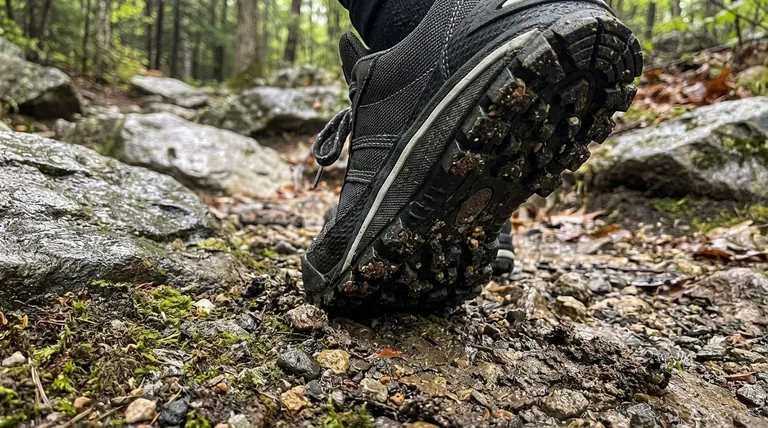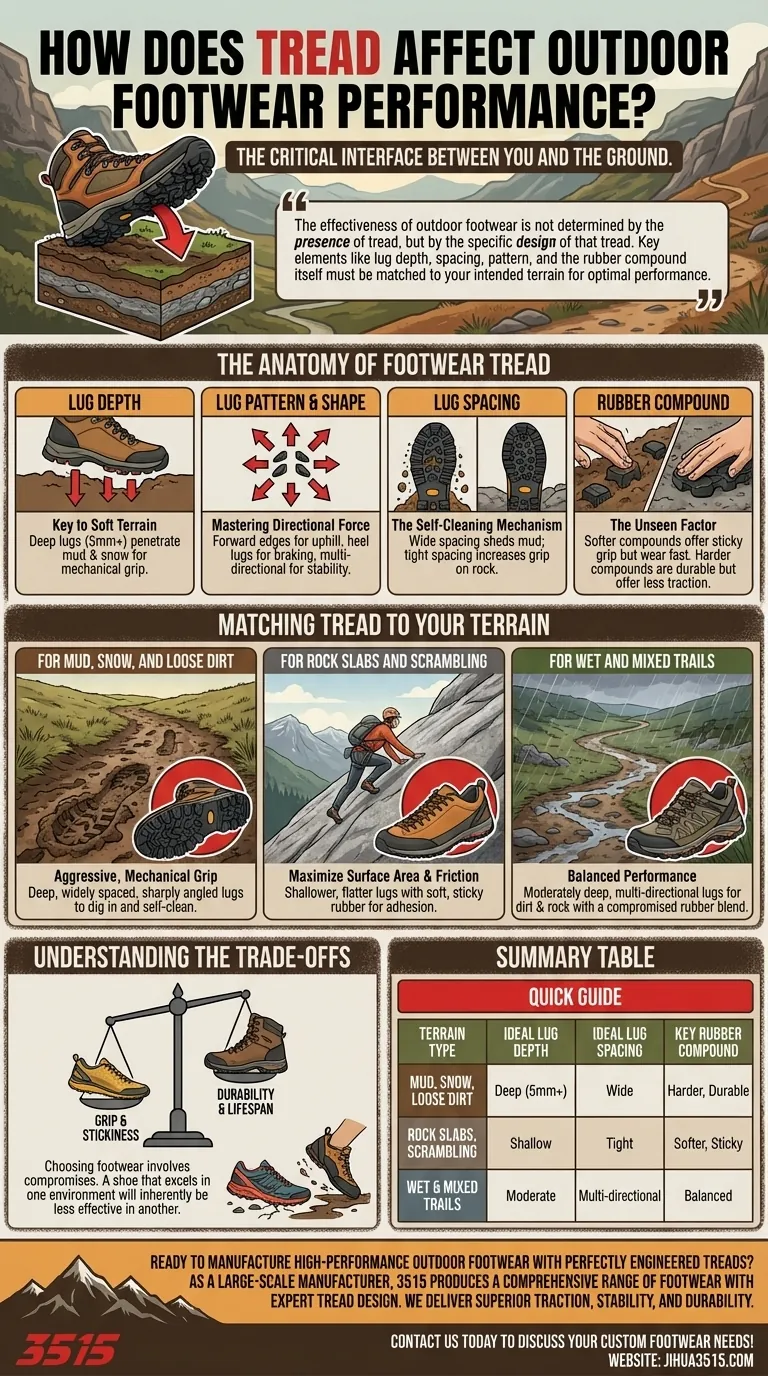In short, tread is the critical interface between you and the ground. Its primary function is to provide traction (grip) and stability by using a system of lugs—the knobs and patterns on the bottom of your shoe—that are specifically designed to interact with different types of terrain. Deeper, more aggressive lugs excel on soft ground, while stickier, lower-profile designs are better for rock.
The effectiveness of outdoor footwear is not determined by the presence of tread, but by the specific design of that tread. Key elements like lug depth, spacing, pattern, and the rubber compound itself must be matched to your intended terrain for optimal performance.

The Anatomy of Footwear Tread
To understand performance, you must first understand the components of a shoe's outsole. Each element serves a distinct purpose, and how they are combined defines the shoe's ideal use.
Lug Depth: The Key to Soft Terrain
Deep lugs, often 5mm or more, are designed to physically penetrate soft surfaces like mud, snow, or loose dirt.
By digging into the ground, these lugs create mechanical grip, preventing your foot from slipping where simple friction would fail.
Lug Pattern & Shape: Mastering Directional Force
The orientation of the lugs is crucial. Multi-directional lugs, with varied angles and shapes like chevrons or triangles, provide reliable traction in all directions.
Forward-facing edges on the forefoot aid in propulsion when going uphill, while sharp, rear-facing heel lugs act as a brake for confident control on descents.
Lug Spacing: The Self-Cleaning Mechanism
The space between the lugs is as important as the lugs themselves.
Wide spacing allows the shoe to shed mud and debris easily. If lugs are too close together on a muddy trail, they will clog up, turning your outsole into a single, slick surface.
Conversely, tighter spacing increases the surface area of rubber in contact with the ground, which is ideal for gripping on solid rock slabs.
Rubber Compound: The Unseen Factor
The material of the outsole determines its stickiness and durability. Softer rubber compounds offer exceptional grip, conforming to microscopic irregularities in rock, but they wear down much faster.
Harder rubber compounds are far more durable and will last longer, but they often provide less traction, especially on wet or smooth surfaces.
Matching Tread to Your Terrain
There is no single "best" tread design. The right choice is a direct reflection of the ground you will be walking on most often.
For Mud, Snow, and Loose Dirt
On these surfaces, your primary need is aggressive, mechanical grip.
Look for footwear with deep, widely spaced, and sharply angled lugs. This design ensures the tread can dig in for traction and clear itself with every step to maintain performance.
For Rock Slabs and Scrambling
Here, performance relies on maximizing surface area and friction.
The ideal tread features shallower, more numerous lugs with a larger, flatter contact area. A soft, "sticky" rubber compound is paramount for adhering securely to rock.
For Wet and Mixed Trails
This is the most common scenario for general hiking and requires a balance of features.
A good all-around tread will have moderately deep, multi-directional lugs to handle patches of both dirt and rock. The rubber compound will be formulated as a compromise between sticky grip and long-term durability.
Understanding the Trade-offs
Choosing footwear always involves accepting compromises. A shoe that excels in one environment will inherently be less effective in another.
Grip vs. Durability
This is the fundamental trade-off in rubber compounds. The stickiest shoes used for climbing and canyoneering have outsoles that can wear out remarkably fast, while durable boots may feel slick on wet rock.
Specialization vs. Versatility
A fell running shoe with 8mm lugs is a master in the mud but will feel unstable and wear quickly on a hard, rocky trail. An approach shoe designed for rock will offer little security on a steep, grassy descent.
Trail Performance vs. Pavement
Deep, aggressive lugs feel awkward and wear down rapidly on concrete or asphalt. If your outdoor activities involve significant walking on paved surfaces, a less aggressive, hybrid tread is a much better choice.
Making the Right Choice for Your Activity
Analyze your primary use case to select the footwear that will serve you best.
- If your primary focus is muddy trails or off-trail hiking: Choose a shoe with deep, widely spaced, and aggressive multi-directional lugs.
- If your primary focus is scrambling or hiking on slickrock: Prioritize footwear with high surface area, shallower lugs, and a specialized sticky rubber compound.
- If your primary focus is all-around trail hiking on varied terrain: Look for a versatile design with moderate lug depth and a balanced rubber compound that blends grip and durability.
By understanding the language of tread, you can confidently select the right footwear to keep you stable and secure on any adventure.
Summary Table:
| Terrain Type | Ideal Lug Depth | Ideal Lug Spacing | Key Rubber Compound |
|---|---|---|---|
| Mud, Snow, Loose Dirt | Deep (5mm+) | Wide | Harder, Durable |
| Rock Slabs, Scrambling | Shallow | Tight | Softer, Sticky |
| Wet & Mixed Trails | Moderate | Multi-directional | Balanced |
Ready to manufacture high-performance outdoor footwear with perfectly engineered treads?
As a large-scale manufacturer, 3515 produces a comprehensive range of footwear for distributors, brand owners, and bulk clients. Our production capabilities encompass all types of shoes and boots, with expert tread design tailored to your target terrain. We help you deliver superior traction, stability, and durability to your customers.
Contact us today to discuss your custom footwear needs and get a quote!
Visual Guide

Related Products
- Durable Rubber Sole Outdoor Shoes Wholesale & Custom Manufacturing
- Safety Footwear Wholesale Manufacturer for Custom OEM/ODM Production
- Durable Rubber-Soled Utility Shoes for Wholesale & Custom Brand Manufacturing
- Advanced KPU Athletic Safety Shoe with Steel Toe Cap Anti-Slip Rotary Lacing System
- Custom OEM Training Shoes Wholesale Manufacturer Durable & Breathable
People Also Ask
- What were traditional shoe soles made from before rubber? The History of Leather Soles
- What are the main applications of vulcanized rubber? Unlock Durability for Tires, Footwear & More
- What are the disadvantages of vulcanized soles? Lack of Support & Durability Explained
- How do hiking shoes or boots protect feet from environmental hazards? A Guide to Trail-Ready Footwear
- How does cushioning work in hiking shoes? The Science of Shock Absorption



















